THE Choir Trainer's TOOLKIT
Elementary Arranging
Without knowledge of Harmony or Counterpoint
As mentioned in the Introduction, it's important that a choir, however small, has new goals to work towards. This page assumes that you have very
few resources to call upon, the chance of being granted a meaningful budget remote, and that the number of your singers is small.
Even with such unencouraging circumstances, there's much which can be done.
You may end up doing quite a bit of arranging - and armed with nothing more than some manuscript paper (find some HERE) and access to a photcopier you would have all you need.
However, most singers are happiest singing from printed music rather than a manuscript, so, if possible, download a free music typesetting programme and learn to use it. Musescore is quite popular, but you might also want to investigate Finale Notepad, LilyPond, or anything else that Google suggests.
A Word About Copyright
As this page talks about arranging, there is the possibility of running up against copyright laws. This varies from juristiction to juristiction and that about to be summarised applies to
the UK/EU so, if you are really worried about this, check if necessary.
- Copyright exists on original works until the end of the year during which falls the 70th anniversary of the copyright owner's death. For example, if the owner died at 00:00:01 on 1st January 1950, the copyright exists until 23:59:59 31st December 2020.
- With a music work, there can be separate copyright on the melody, harmony, arrangement, text, translator etc. So, if a genius 10 year old produces a new work today, in 60 years from now another genius 10 year old adds a text, and 60 years later still another wunderkind supplies a translation,
it's going to be a long time before the whole thing is completely copyright free.
- If a piece exists in the Public Domain (all copyright has expired) and somebody makes a new arrangement, that arrangement is now copyright, but anybody can use the piece in its original form.
- Graphic copyright exists on printed pages for 25 years. This means, even if every aspect of a piece is copyright free and now exists in the Public Domain, it's not permissable to photocopy (hand copying is fine) the piece for 25 years from the time of first modern printing. However, this does not apply to reprints. If a work is printed in 2010, the graphic copyright expires at the end of 2035, even if the the work is reprinted several times.
RETURN TO
TOP
MENU - The Choir Trainer's Toolkit
MENU - Organists Online
Background Knowledge
To get the best from this page, it's essential to have a good grasp of key-signatures (see
HERE and HERE) and
intervals (see HERE and
HERE). On the other hand, it's NOT necessary to have any experience with harmony and counterpoint.
RETURN TO
TOP
MENU - The Choir Trainer's Toolkit
MENU - Organists Online
Vocal Range and Transposition
It's fairly obvious that our hymn books are full of tunes and hymns that our congregation is never going to sing. This is so obvious that it's only mentioned here for the sake of completeness. Any one
of these can be performed as a little anthem - absolutely straight, without frills or embellishments.
HOWEVER!!
If the choir is going to sing on its own, it has to sound as good as possible. You don't want the congregation to be looking at their watches, longing for you to cease, and you don't want to put off
potential new members, so it's important to select something that lies within the range and capability of your singers. If you are reading these pages, you probably have a small choir of just a few
voices, singing in unison, so it's important to take into consideration those singers who are not natural tenors (if you are lucky enough to have any men) or sopranos.
Generally speaking, singers who describe themselves as sopranos have a range something like this:
 If there's anything below middle C, they will start to grumble, and top G marks the limit for most of them, and that means only the occasional top note. Too many of them, and the sound will soon suffer.
If there's anything below middle C, they will start to grumble, and top G marks the limit for most of them, and that means only the occasional top note. Too many of them, and the sound will soon suffer.
On the other hand, altos tend to be happier with
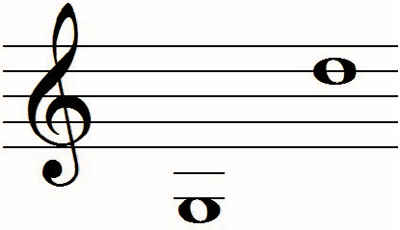
If all upper voices are going to be singing in unison, that leaves an effective, universally strain-free range of:

The same line of thinking applies to men: a range of C below middle C to D above middle C is most comfortable for the majority.
Just as some tenors and sopranos are liable to struggle with too many top G's, the same applies to basses and altos with top D's, so the really safe range for
women's voices is middle C to the octave above, and for men from tenor C to middle C. Much straying outside these ranges is not recommended.
(But please remember that we are talking about unison choirs here, not choirs singing in parts.)
So, getting back to the matter in hand, if choosing a hymn as a little anthem for a unison choir, it's important to take the range of the melody into consideration. In many hymns books, especially older ones,
the melodies are harmonised for SATB singing, so the melodly lies well above the recommended safe range.
Suppose, for instance, that your little unison choir decides to sing Come, ye faithful, raise the strain as an Easter anthem to the tune Ave Virgo Virginum.
In many hymn books, this is printed in G major:
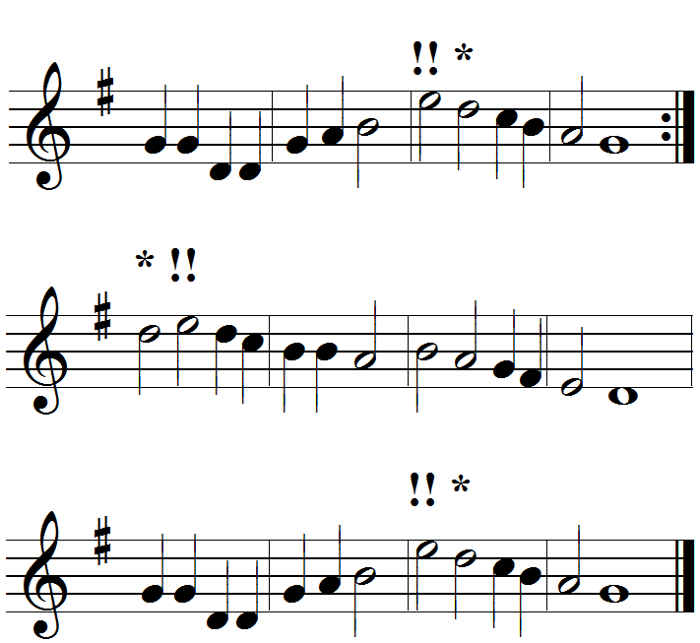 At * and !! there are notes which are likely to really test the upper range of some people. Although most should (may?) be able to cope with the * notes, these copers are likely to give the !! notes a miss.
Allowing for the repeat, that's eight straining notes in one verse, and thirty two if all four verses are sung. This melody would be much better sung in F major:
At * and !! there are notes which are likely to really test the upper range of some people. Although most should (may?) be able to cope with the * notes, these copers are likely to give the !! notes a miss.
Allowing for the repeat, that's eight straining notes in one verse, and thirty two if all four verses are sung. This melody would be much better sung in F major:
 in which case there are no extreme high notes, and only four top-range notes per verse - something which many singers would be grateful for.
in which case there are no extreme high notes, and only four top-range notes per verse - something which many singers would be grateful for.
In other words, for a successful outcome with hymn-anthem singing, it's going to be necessary to transpose quite a lot of repertoire down. If you or your organist (if you have got one) can transpose
at sight, this is not much of a problem. Otherwise, things have got to be written out in a transposed key. This is a minor problem if you are confident using music-writing software (more of this later) as
the software will transpose for you. If not, it's back to old-fashioned hand transposition. To do this well,
it's essential to have a good grasp of key-signatures (see
HERE and HERE) and
intervals (see HERE and HERE).
And, just in case a bit more help is needed, there's a whole page about transposition HERE.
To be strictly legal, if copyright exists on the hymn in any form, it's an offense to computer set it, print transposed copies, etc, etc. However, in the hurly, burly of copyright dispute, I don't suppose anyone
would really mind if a transposed copy is produced for the organist and the choir sings from hymn books, especially if the use is limited and local.
RETURN TO
TOP
MENU - The Choir Trainer's Toolkit
MENU - Organists Online
Simple Hymn Tunes
We are going to look at slightly more adventurous use of existing material. So, to make sure that we are squeaky clean copyrightwise, it's probably best to stick to pieces that, in all aspects,
are in the Public Domain. These can be found in new hymn books, but are more prevalent in older books.
If you are reading these pages, it's quite likely that your church isn't a place of super-hip administrators who have everything cleaned up and efficient. Somewhere in a vestry cupboard, or still lying in choir stalls as yet unrationalised, are old hymn books. You are more likely to find Public Domain material in these, and the older they are, the better source of material they are likely to be. However, older hymn books
tend to print tunes in higher keys than more modern ones, so transposition skills are going to be more necessary.
The following examples are based on the hymn tune Manchester. The composer and harmoniser of this was Richard Wainwright who died in 1825 - so there's no danger of any copyright infringement. Here is the melody:
And here it is with the most basic, prosaic introduction:
which is, allowing for the fact that this is supposed to be a hymn anthem, pretty dull.
So here's something with a bit more interest:
Echos have been added to the opening introduction, and the last line of the tune added on.
If you are going to use echos, experiment a bit to see if they can be included without some remarkable, ear-catching harmonic bump.
Here's something with even more interest:
In this case, an echo and repetition have been added to the last-line interpolation.
A similar approach may be used for interludes between the verses:
The inter-verse interlude is taken from the second phrase of the melody.
Echos and repetition can be added to the interlude as well:
We've got to the point now where the choir has no more to do than sing a unison hymn tune, but a larger piece with some structure has been produced, without any knowledge of harmony and counterpoint.
(Also, incidentally, some creativity has gone into this {deciding on the echos and what to use for interludes} so this is a copyright arrangement, with the copyright owned by you.)
RETURN TO
TOP
MENU - The Choir Trainer's Toolkit
MENU - Organists Online
Combining Tunes
But we don't have to stop here. So far everything, the choir's part, and all the introduction and interludes have been derived from one short piece of music. This may begin to seem a bit boring. But the same hymn book you mined
to find your melody is full of ready-made harmonic passages and melodies which, being forgotten, can be selected at will.
Firstly, a copyright free tune of the same metre as the main tune needs to be selected. Ideally, it should have a similar phrase structure to the main melody as well. In this case, St Petersburgh by Bortniansky has been chosen:
It's been transposed into the same key, it's got 3 beats in the bar, and each phrase starts with an up beat - all the same as our main tune.
The only reason a hymn playover consists of the first line or so is to let a congregation know what they are about to sing. There's no particular need for this with a hymn anthem as the choir already knows
what is coming up and (hopefully) is prepared. Therefore, any part of the second tune we have chosen can be used as an introduction (with our without echos etc) and interludes.
In this example, the first line of St Petersburgh is treated to echos and repeats as an introduction. As an interlude, the second line of St Petersburgh is echoed, and then the last phrase runs into the next choral verse.
As, structurally, we now have something like a a Baroque chorale fantasia, we could have some interludes between the lines of the hymn text.
It's possible, therefore, to create little, coherent anthems with no composing knowledge, with some variation in the accompaniment, but which create no performance problems for the choir.
At this point, it would be no surprise if the choir is getting bored with singing just unison, so we shall look at the next stage - actual composing by rule-of-thumb.
RETURN TO
TOP
MENU - The Choir Trainer's Toolkit
MENU - Organists Online
Rule of Thumb Composing
For this section, we are going to use the tune "St Sepulchre", transposed down to C major.

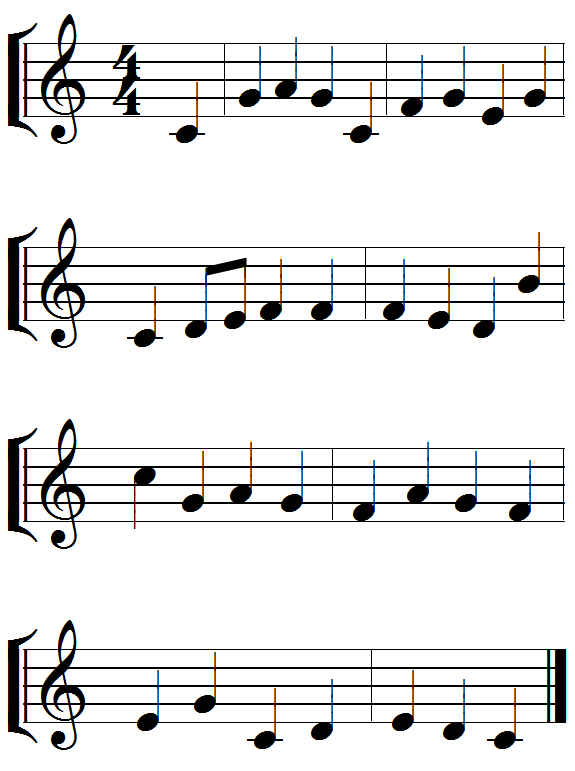
We are going to look at ways of adding a second part, but assuming no knowledge of harmony. So, firstly, four basic rules:
- Use only unisons, 3rds, 6ths, 8ves and their compounds (that is, the interval + an octave):
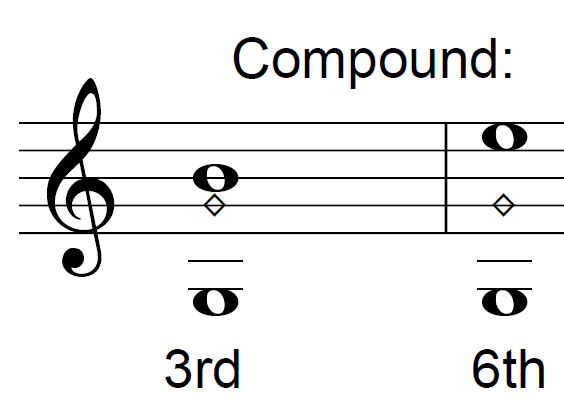
- Avoid consecutive (one directly after another) unisons and/or 8ves (unless they stay at the same pitch;
- Avoid large leaps (7ths, 9th, etc) [but 6ths and 8ves are fine];
- The last lowest note should be the key note or tonic.
With these four rules, it's possible to write a completely acceptable second part. It may not be wonderful, but it will be adequate and do the job. Having said that, if you have the opportunity
to play over your work, that's an advantage, as some solutions (working within the four rules) will be better than others.
Here is an added alto part.
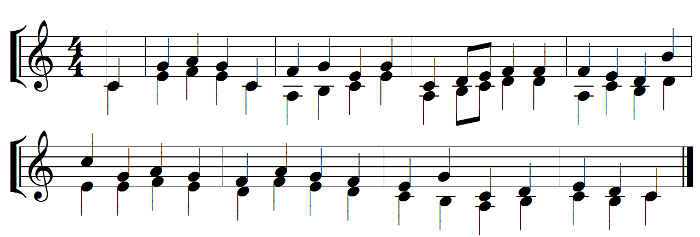
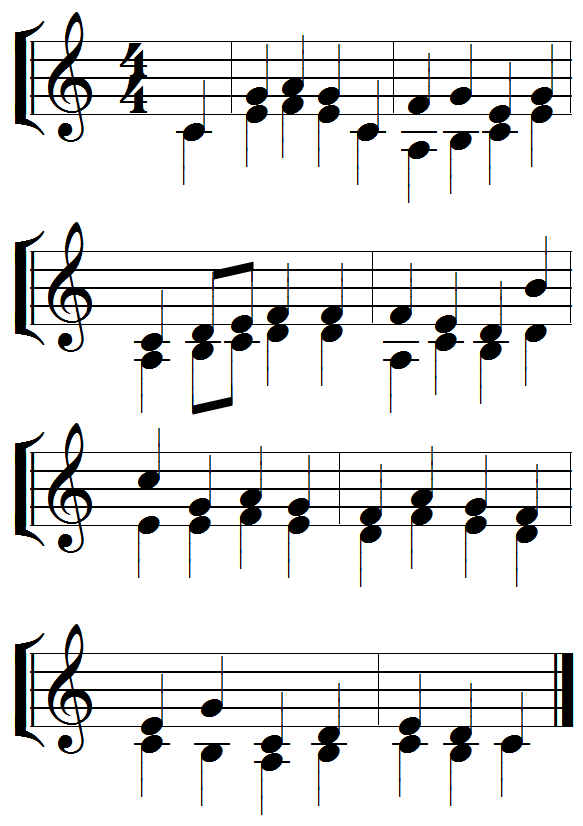
As it's specifically an alto part, it can go below middle C. Have a careful look at it and you will notice that it obeys all the four "rules". It sounds like this:
Nobody is going to claim that this is wonderful, but it does its job and shouldn't present any great technical difficulties to timid altos.
We could have allocated the melody to the altos and written a soprano descant. In such a case, there would be no need to restrict the sopranos to lower notes only.

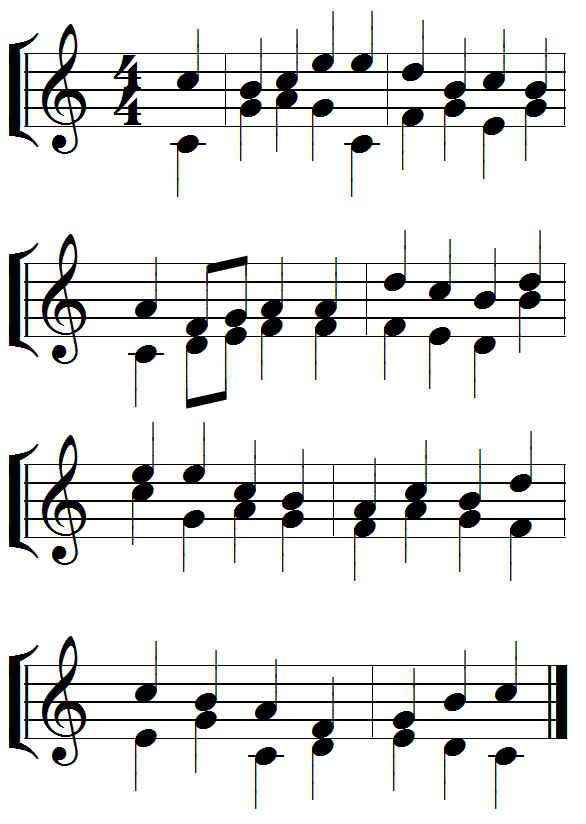 Once again, the descant has been added according exactly to the four "rules". It sounds like this:
Once again, the descant has been added according exactly to the four "rules". It sounds like this:
When writing the alto example, the notes could stray down into the natural alto range, and when writing the soprano descant, upper notes were not forbidden.
This example is not marvellous, but servicable. Additionally, as the alto melody lies within the restricted general range set out above, any men in the choir could also participate in their own octave.
If writing a lower part for all men, it's necessary
to keep within the general range that all of them could manage, such as this:
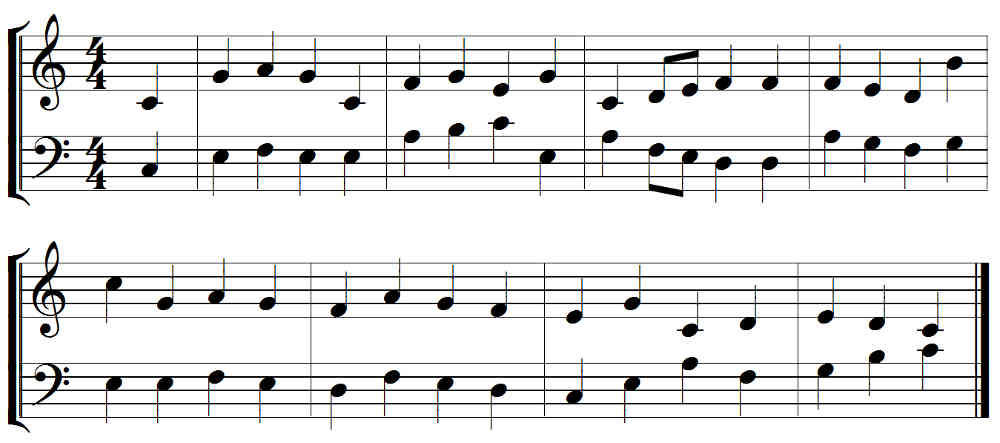
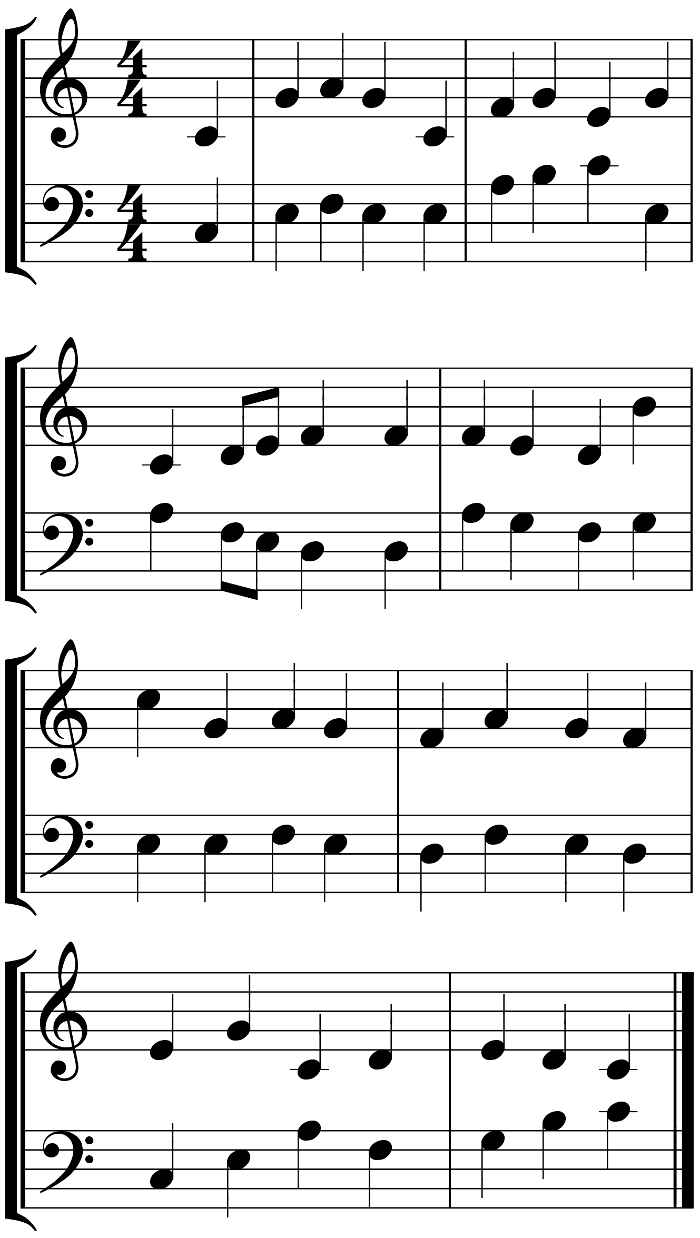 which sounds like:
which sounds like:
So far, what we have written is safe, secure, and just a little bit dull. The added parts are plodding, note-for-note in the same rhythm as the hymn tune. So we shall look at ways of adding interest.
RETURN TO
TOP
MENU - The Choir Trainer's Toolkit
MENU - Organists Online
Adding Interest
So far, we have had four rules, now we will have four suggestions. As suggestions, they can be ignored entirely
without compromising the basic function of this page - to enable simple arrangements to be made.
- MOVING BY STEP, short value passing notes may be added between main notes a 3rd apart.

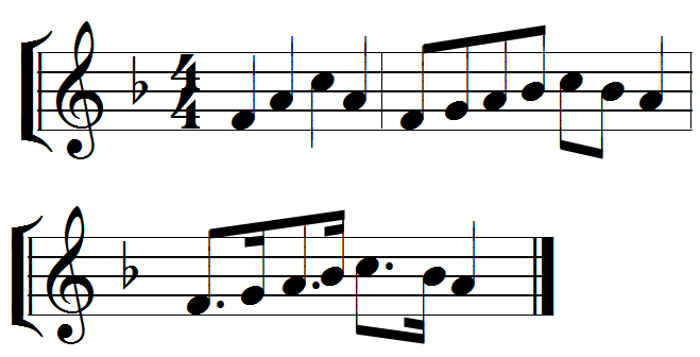
- MOVING BY STEP, short value auxiliary notes may be added between main notes at the same pitch, either above or below.

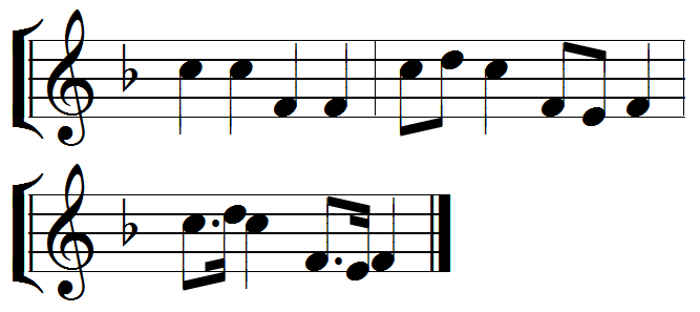
- REPEATED notes or notes MOVING BY STEP may be may be rhythmically altered.

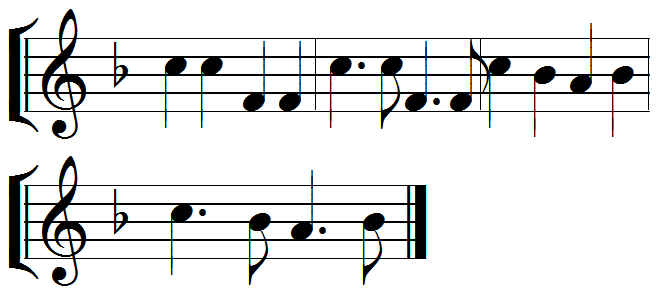
- If the two parts seem a little bare when accompanied, add a note a 3rd above the accompaniment bass note at that place.

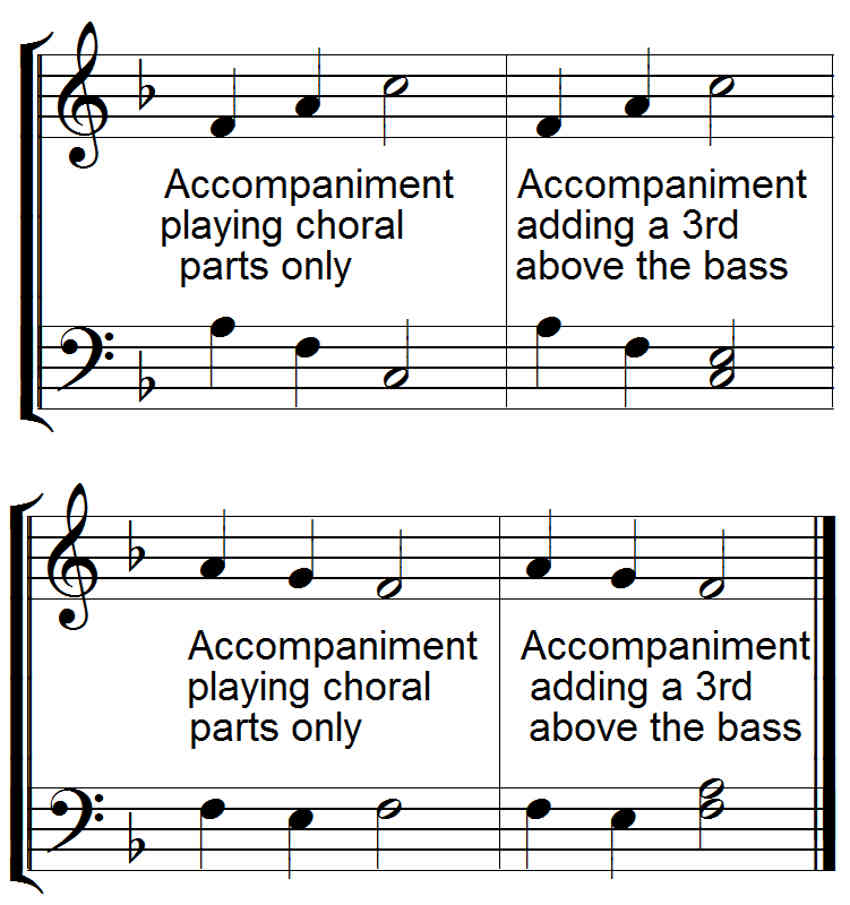 In rare cases, using the rules, a final chord may not have the keynote or Tonic as the lowest note. In such a case, in parallel with the above examples, just place one in the accompaniment.
In rare cases, using the rules, a final chord may not have the keynote or Tonic as the lowest note. In such a case, in parallel with the above examples, just place one in the accompaniment.
Armed with these suggestions, we can go back to the arrangment with an additional part for men and add more interest to it. The red, middle stave is the original version, placed there for reference.
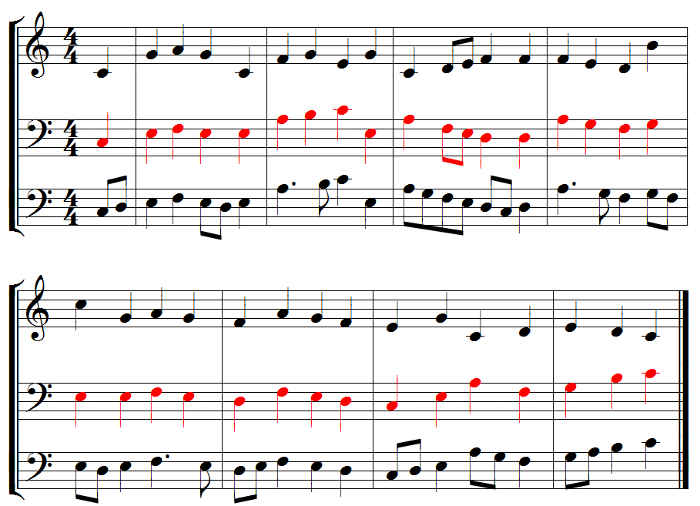

Here is the arrangement for a soprano descant given the same treatment.
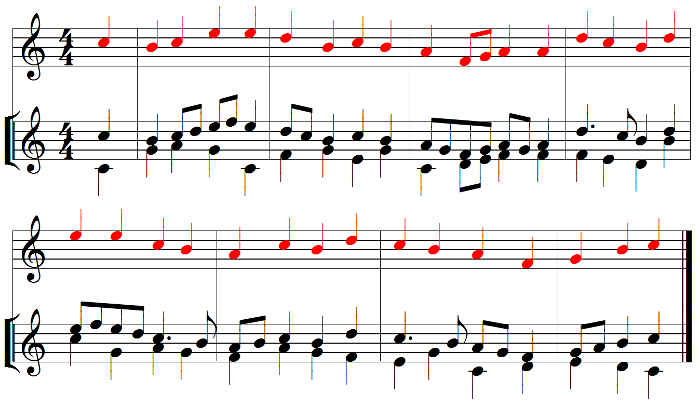
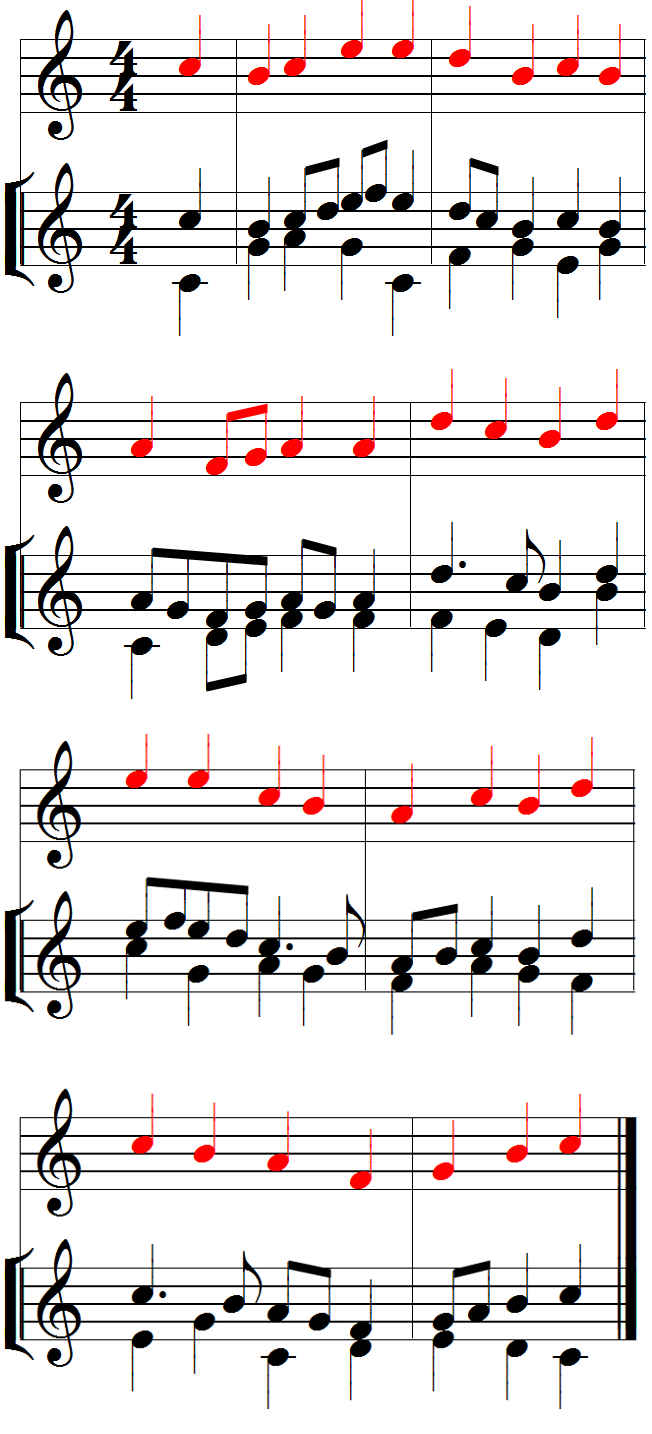
RETURN TO
TOP
MENU - The Choir Trainer's Toolkit
MENU - Organists Online
Summing Up
We can now bring all the threads together: selecting sections from another hymn tune, adding interludes, and adding an additional part either above of below the hymn melody. For this demonstation of possibilities,
we are going to combine St Sepulchre (the hymn tune we have been using) with Erfurt (also known as Vom Himmel Hoch).The melody itself and
this harmonisation are completely copyright free.
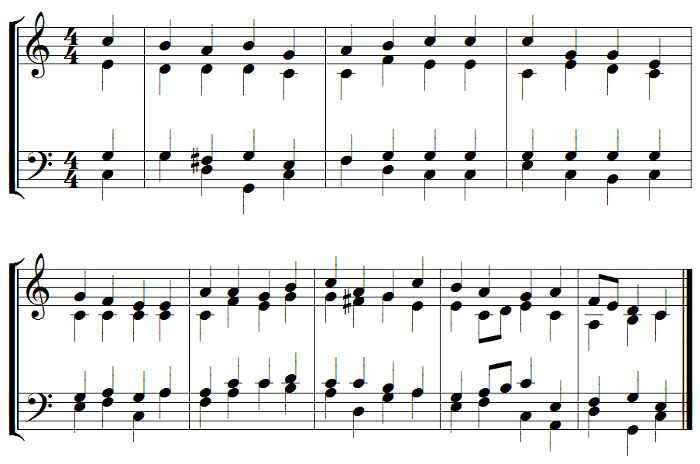
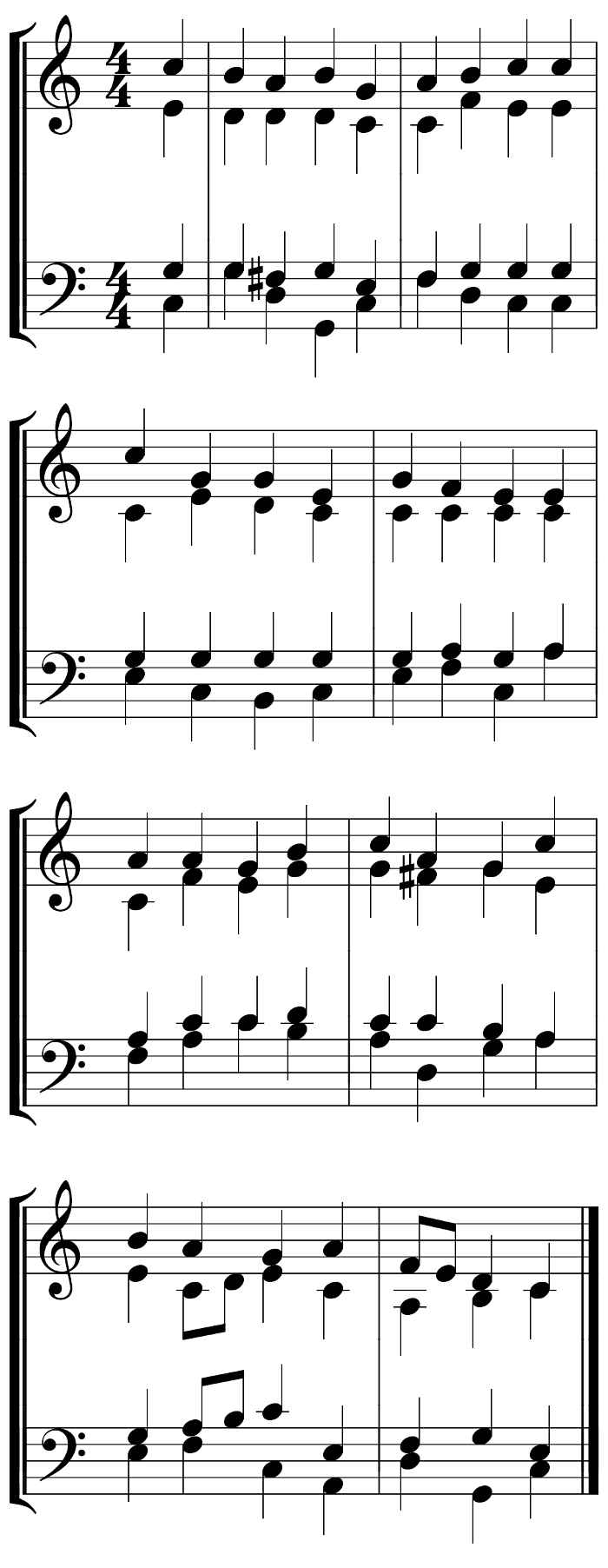
And here they are, all combined in a video with comments.
Once again, nobody is going to claim that this is a great composition, but it has been put together with no knowledge of harmony or composing, using four rules and four suggestions.
By using the four rules when adding a second part, you have actually written
invertible or double counterpoint, the holy grail for counterpoint students. This means that either
the melody can be at the top or the bottom, or the bass can be at the bottom or the top, and the harmony still makes sense. If you have written something where the S/A part and the men's part both fall
within the general range for voices, you can save yourself writing time and the choir learning time by just inverting the parts. Here is the version from above with an additional men's part so treated.
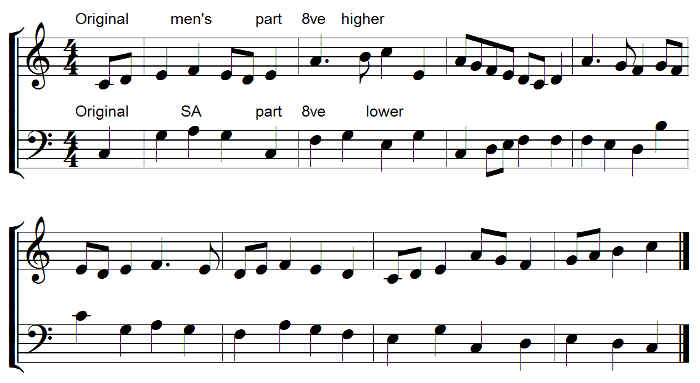

RETURN TO
TOP
MENU - The Choir Trainer's Toolkit
MENU - Organists Online
Further Study
It's impossible to give just a few simple rules to aid arranging in 3 or more parts. A search on Google will bring up many sites teaching harmony, their worth being variable. Also, it's hard to learn such
a subtle art on your own without a teacher.
You can find a list of teachers via this LINK.
RETURN TO
TOP
MENU - The Choir Trainer's Toolkit
MENU - Organists Online
Test Yourself
You can practise any of the skills above using any hymns tunes. Adding a second part is the most difficult and it's easy to let slips and errors go unnotices. Here are seven tests with errors for you to correct.
Test 1, Test 2, Test 3, Test 4, Test 5, Test 6, Test 7
RETURN TO
TOP
MENU - The Choir Trainer's Toolkit
MENU - Organists Online